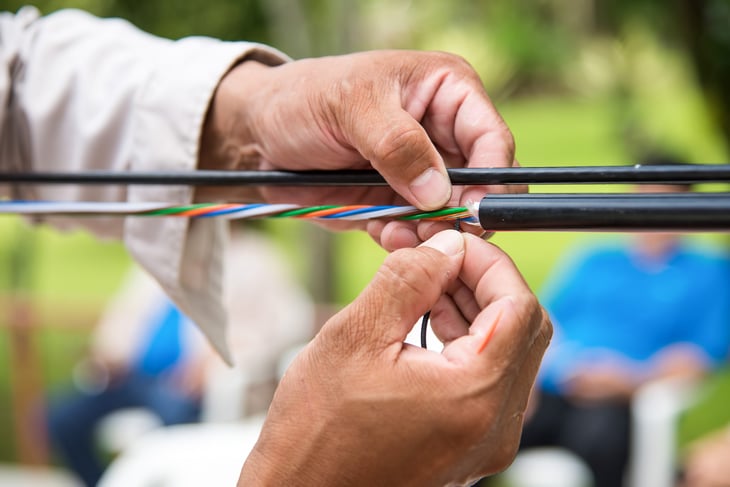
This story originally appeared on HighSpeedInternet.com.
Predicting tech trends is hard. Getting them wrong can also be expensive, as anyone who’s ever tried to take notes on their Apple Newton while riding a Segway can tell you. For some, however, this is just the price you pay to be on the cutting edge of technology.
While no one can say when we’ll get our flying cars and personal jetpacks, we can say a lot about the future of the internet. Internet service providers (ISPs) and other telecommunications companies are already laying the groundwork for the next big trends in the way we use the internet.
Keeping ahead of the curve can be a matter of life and death for tech companies, but it’s not a bad idea for consumers, either. Here’s a look at how the internet is changing, as well as some things that aren’t changing anytime soon.
The future is fiber

Before we get into the list, it’s important to get this clear: The importance of fiber is one thing that isn’t changing. Fiber certainly isn’t new; it’s been around since the 1960s. It also makes up the backbone of the internet worldwide. Although technologies like cable connections can almost match current fiber plans in pure download speed, nothing has as much potential for future growth as fiber.
Fiber also allows ISPs to plan for the future in more tangible ways. Fiber-optic cables can be laid with “dark fiber.” These are extra fibers that aren’t initially used to transmit any data. When demand in an area increases, these extra fibers can simply be switched on to support the increased traffic without having to replace the existing cables.
Despite the prevalence of fiber-optics throughout the history of the internet, fiber-to-the-home represents only a small percentage of home internet connections in the U.S. Although many ISPs are expanding their fiber infrastructure, others are struggling to keep up with demand. An underinvestment in fiber infrastructure was one of the underlying reasons behind Frontier Communications’ recent bankruptcy.
So the next time you’re looking for a new internet service, you should check to see if there’s a fiber provider in your area. While technologies like DSL are waning in popularity, fiber is not going anywhere. And you’re going to want that speed and reliability for some of the new stuff that will be coming your way.
1. The ‘Internet of Things’ is outpacing traditional devices

With the ever-increasing popularity of devices like smartphones, tablets and smart TVs, it might come as a surprise that none of these are the fastest-growing segment of internet-enabled devices. In actuality, the fastest-growing category of devices is those using machine-to-machine (M2M) communication.
M2M communication has been around for a long time in manufacturing and robotics; however, these technologies are now expanding into the home as the framework powering the Internet of Things (IoT). Within the next three years, these connections will account for over half of all internet-connected devices.
The Internet of Things is M2M communication on a grand scale. Instead of specialized robots on an assembly line communicating with one another to do their work, IoT takes a much more flexible, generalized approach. This allows consumers to connect a wide range of devices together — from lightbulbs to coffee makers to home security systems — and connect them to cloud-based app. This lets you control them from your cellphone or by simply telling Alexa to do it for you.
The Internet of Things is more than just an ecosystem for smart homes. It’s also being used to create smart cars, smart manufacturing, smart energy grids, smart health care and smart cities.
2. New types of communication and collaboration

The machines in our homes aren’t the only ones that are going to be using the internet more in the future. Our own forms of communication, collaboration, and entertainment are going to become more bandwidth-heavy as well.
Some of these trends will be incremental changes to our current online habits. Is your internet connection fast enough to stream 4K UHD video? TVs with 8K resolution are already appearing on the market, and tech companies are already making plans for 12K video just over the horizon.
Other trends will be driven by entirely new types of online activities. Many engineers and software developers are looking to virtual reality (VR) and augmented reality (AR) as powerful new tools not just for entertainment but also for communication and collaboration. Tools like VR Chat give users a space to gather and express themselves and can help create virtual film studios for real-world applications.
Not surprisingly, these technologies will need a hefty internet connection to function. Streaming 8K video will require more than six times the bandwidth as current 4K streaming and UHD VR will require more than 30 times as much speed as your 4K TV needs.
3. Wi-Fi 6 is changing Wi-Fi

With our home networks soon to be filled with dozens of internet-enabled devices, some of them incredibly bandwidth-hungry, we’ll need more than just fast fiber connections to our homes — we’ll also need much better wireless networks.
Fortunately, that technology is already here: Wi-Fi 6, which is more than just a faster version of Wi-Fi. It makes use of a number of new technologies to improve your wireless network in important ways. Wi-Fi 6 uses multi-user, multiple input and multiple output (MU-MIMO) and similar technologies to not only deliver faster speeds (though that is certainly part of it), but also to allow many more devices to connect to your network without getting bogged down with traffic. This is a handy feature to have in a connected home. Wi-Fi 6 has even more features, such as ones to make connecting to a network easier and ones to improve the battery life of your devices.
Because of these improvements and flexibility, Wi-Fi 6 is expected to completely replace Wi-Fi 5 at a record pace. (Wi-Fi 5 still hasn’t replaced the standards that came before it.) Another important but often overlooked aspect of Wi-Fi 6 is its branding. The Wi-Fi Alliance’s decision to brand the 802.11ax standard as “Wi-Fi 6” makes it much easier for consumers to make informed decisions. Few people know the difference between the previous five Wi-Fi standards or even what order they came in (they don’t go in alphabetical order), but it’s easy to see that Wi-Fi 6 is the replacement for Wi-Fi 5, so consumers will be able to ask for it specifically.
Wi-Fi 6 routers are already on the market, so if you are planning on buying a new wireless router in the next few years, make sure you buy a router with Wi-Fi 6. They’re backward compatible with your current devices, so you don’t have to replace every gadget in the house if you get one now. Additionally, as you do begin to upgrade to Wi-Fi 6 devices, you’ll be able to take advantage of more of your router’s features, essentially making your router improve over time.
4. ISPs want a new image and a new business model

Another big change is the way that internet providers want to be viewed by their customers. Right now, the internet is a commodity and ISPs simply provide the pipe. If a competitor has a bigger pipe that can give customers more speed for a cheaper price, everyone will switch. There’s no reason to stick with more expensive service because the product is identical. This is part of why the U.S. broadband market is riddled with anticompetitive behaviors — locking customers into expensive contracts, stifling competition and maximizing switching costs. This, in turn, has consistently earned major ISPs places on lists of the most hated companies in the U.S.
ISPs would much rather differentiate themselves from the competition in the way that other tech companies like Apple and Google are able to. As such, many ISPs have been moving toward not just providing internet, but providing an experience. Many ISPs already offer companion apps and services like managed Wi-Fi.
As this trend continues, we might see ISPs moving into smart home services, competing with the likes of Google Home and Amazon Alexa. There is also the potential for other services that ISPs are in a prime position to offer, such as integrated security built directly into residential gateways, protecting the home network from malware. ISPs could also develop services like parental controls that give granular control over all the devices on the home network.
5. Online security will become more difficult

One theme you might have noticed throughout this article is that ever more software and devices will be coming into our homes. As exciting as these developments might be, they also raise concerns about privacy and security. Every connected device is a potential access point to your network.
There are a few things that you can do to improve your security. You can buy a more secure router. You can enable the highest security protocols available on your network and make sure that your antivirus and any other security systems are up to date. You can even start using a password manager to keep your login credentials safe.
Of course, not all the responsibility for online security is yours. Not everyone who uses the internet can be a security expert, and in the future, that’s what we might need. ISPs will have to play a more active role in keeping residential networks secure, which means that services like integrated security built into the residential equipment might become more of a selling point to customers.
How to plan for the future

A lot of exciting changes, as well as several challenges, will be coming to the internet over the next few years. Some of these changes will happen one way or another, but there are definitely steps you can take to be ready.
First, get a fiber internet connection if one’s available in your area. If not, there are some steps you can take to speed the process along, but the U.S. is still lagging behind when it comes to fiber infrastructure.
Second, keep an eye out for Wi-Fi 6 routers. There’s no need to go out and buy one right away since most devices aren’t compatible with Wi-Fi 6 yet, but you should definitely look into Wi-Fi 6 the next time you’re upgrading your wireless router.
Peter Christiansen is an internet expert with HighSpeedInternet.com.





Add a Comment
Our Policy: We welcome relevant and respectful comments in order to foster healthy and informative discussions. All other comments may be removed. Comments with links are automatically held for moderation.